Madhuca longifolia: Butter Tree: Uses, Remedies, Research, Side Effects
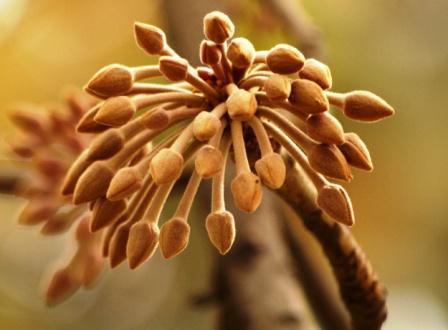
Madhuka- Madhuca longifolia (Koen.) is used as a fermenting initiater in many Ayurvedic medicines. It is described in Ayurveda for treating skin diseases, nerve disorders, cough, burning sensation and diarrhea. Madhuca indica is used as the synonym Latin name for the plant Madhuka.
Latin name- Madhuca longifolia, Madhuca indica
Family- Sapotaceae (madhooka kula)
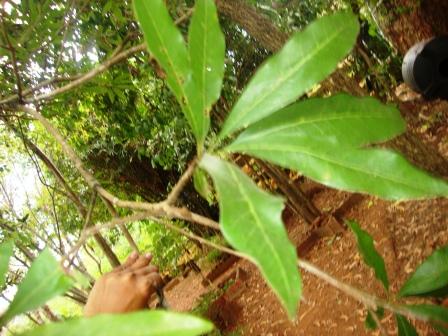
Table of Contents
Vernacular names
Names in different languages:
Hindi name- Mahua, mahva, mahwa
English name- Butter tree, Honey tree
Bengali name- Mahuya, Mohua
Gujarathi name- Mahudo
Kannada name- Hippe mara
Malayalam name- Iluya
Tamil name- Illupi
Telugu name- Ippa Chettu, Ippa puvvu
Sanskrit synonyms
Sanskrit Synonyms of Madhuka:
Madhushteela, Madhura, Madhu, Guda Pushpa, Madhupushpa- The flowers of the plant is sweet in taste
Dola phala- The fruit is round in shape
Hrasvapushpa, Hrasva phala – small sized flowers and fruits
Mahadruma- The tree is large
Deerghapatra – elongated leaves
Teekshna Sara, Elaphala,
Rodhravrushka, Mahadruma – big tall tree
Madhvanga, Madhula, Gaurashakhi, Neeravruksha, Vanaprastha
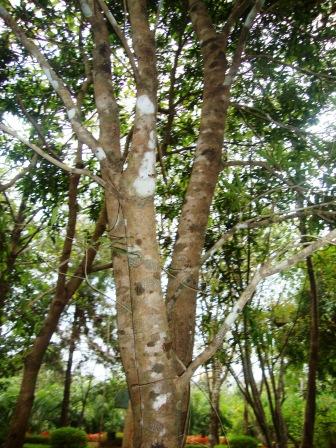
Morphology
Madhuka is a fast-growing tree that grows to approximately 15-18 meters in height, possessing evergreen or semi-evergreen foliage. The tree is found in states of North India like Uttar Pradesh and Bihar. The flowers are pale yellow and sweet in taste from which alcohol is prepared. The fruits are small and round in shape. The seeds of the tree yield oil.
Properties, part used, dosage
Madhuca – medicinal properties:
Rasa (Taste) Madhura (Sweet), Kashaya (Astringent)
Guna (Qualities) – Guru (Heavy), Snigdha (Slimy)
Vipaka – Madhura (Undergoes Sweet taste after digestion)
Veerya (Potency) – Sheeta (Cold)
Karma (Actions) – Vatapitta shamaka (reduces vitiated vata and pitta dosha) Increases Kapha Dosha.
Part used- Flowers, Seeds and Oil
Dosage-
Juice of flower- 10 to 20 ml
Decoction of bark- 50 to 75 ml

Classical categorization
Bhavaprakasha – Amradi phala varga
Dhanvantari Nighantu- Amradi varga
Kaiyyadeva Nighantu- Oushadhi varga
Raja Nighantu- Amradi varga
Shodala Nighantu- Amradi varga
Scientific classification
Kingdom: Plantae
Order: Ericales
Family: Sapotaceae
Genus: Madhuca
Species: M. longifolia
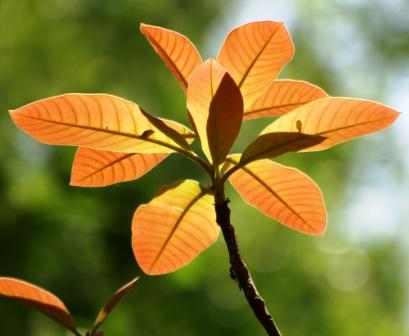
Chemical constituents
Chemical constituents of Madhuca indica:
The fruit pulp yields triterpenoids, n –hexacosanol, beta– D- glucoside of beta- sitosterol. The nut shell has quercetin and dihydroquercetin. The seeds yield saponins-2,3-di-O- glucopyranoside of basic acid. The bark of the trunk contains lupeol acetate, beta- amyrin acetate, alpha- spinasterol, erythrodiol monocaprylate, betulinic acid and oleanolic acid.
Uses
Uses of Madhuca longifolia:
- The oil extracted from the seeds of the Madhuka plant is applied over the area affected with skin diseases and body pain.
- Nasal administration of the fresh juice of the flowers of Madhuka longifolia is done in diseases of vitiated pitta dosha like headache, burning sensation of the eyes etc.
- The dried flowers of madhuka are boiled in milk and administered in a dose of 40-50 ml to treat weakness of the nerves and diseases of the neuromuscular system.
- The decoction prepared from the bark of the tree is given in doses of 30-40 ml to treat Irritable Bowel Syndrome and diarrhea.
- Fresh juice of the flowers is given in a dose of 20- 25 ml to treat hypertension, hiccups and dry cough.
- The flowers of madhuka plant are boiled in milk and added with sugar candy and given in a dose of 40-50 ml to treat less sperm count, premature ejaculation and production of less milk in postpartum period.
- The cold infusion prepared from the flowers or bark of the plant is given in doses of 30-40 ml to treat burning micturition, fever and burning sensation of the body.
- The cold infusion or milk boiled with flowers of the plant is beneficial to patients suffering from general debility.
Sanskrit verse
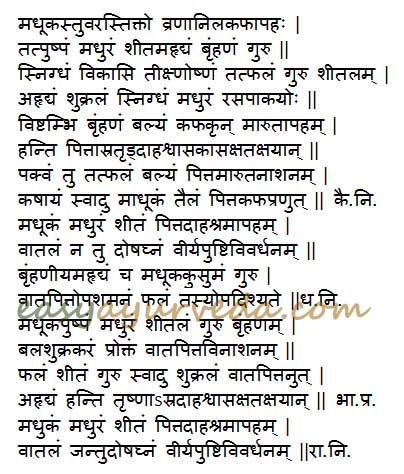
Benefits, indications
Uses as per Ayurveda:
Flowers of Madhuca:
Madhura – sweet
Sheeta – coolant
Ahrudya – not good for heart
Brumhana – nourishing, nutritious
Guru – heavy to digest
Snigdha – unctuous, oily
Vikasi – spreads quickly to all parts of body, loosens joints
Butter tree fruits:
Guru – heavy to digest
Sheetala – coolant
Ahrudya – not good for heart
Shukrala – improves sperm and semen quantity and quality
Snigdha – unctuous, oily
Vishtambhi – causes constipation
Brumhana – nourishing, nutritious
Kaphakrut – increases Kapha Dosha.
Fruit is Indicated in:
Pittasra – Raktapitta –Bleeding disorders such as nasal bleeding, heavy periods, etc
Trushna – excessive thirst
Daha – burning sensation, as in gastritis, neuropathy, burning sensation in eyes etc
Shwasa – asthma and chronic respiratory disorders
Kasa – cough, cold
Kshata – injury, bleeding
Kshaya – depletion of body tissues, weight loss, tuberculosis
Ripe fruit of butter tree:
Balya – improves strength and immunity,
Balances Pitta and Vata Dosha
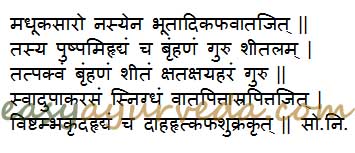
Madhuka oil:
Kashaya – astringent
Swadu – sweet taste
Balances Pitta and Kapha Dosha.
Madhuka seed oil is called Mahua tail, is used for oral intake and for external application in case of toxic and poisoning conditions involving Vata and Pitta Doshas.
It is used in treating snake bite, cancer, migraine, cardiac pains, angina due to Vata and Pitta increase.
It is used externally and orally in the treatment of bone cancer – Vaidya Shri Mohan Lal Jaswal.
Madhuka is used for Nasya to treat
Bhuta – psychiatric disorders, anti microbial
Kapha and Vata disorders
Usage in fermentation:
Madhuka flowers are used as fermenting agent in many Asava and Arishta – fermented alcoholic liquid medicine preparations.
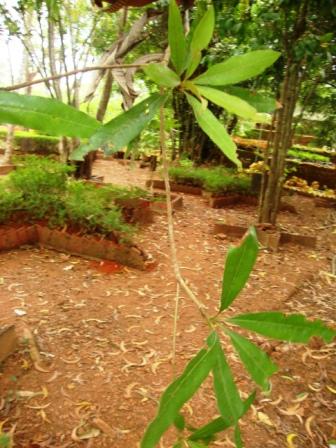
Adverse effects
No adverse effect is reported after the normal use of Madhuka.
It is best to avoid this herb during constipation and in high Kapha conditions.
Interaction with medicines, supplements
Can this be used while taking Homeopathic medicine?
Yes. This product does not react with homeopathic medicine.
Can this medicine be continued while taking supplements like multivitamin tablets, Omega 3 fatty acids etc. ?
Yes. Generally, this product goes well with most dietary supplements. However, if you are taking more than one product per day, please consult your doctor for an opinion.
With western
medicines
Seek your
doctor’s advice if you are taking this product along with other western
(allopathic / modern) medicines. Some Ayurvedic herbs can interact with modern
medicine.
If both Ayurvedic and allopathic medicines are advised together, then it is
best to take Allopathic medicine first, wait for 30 minutes and then take the
Ayurvedic medicine.
Ayurvedic medicines
Formulations containing Madhuka:
Madhukasava: Madhukasavam is an Ayurvedic medicine in liquid form. It is nourishing in nature and used in the treatment of emaciation, after chronic disease, tiredness, bleeding diseases and skin diseases.
Abhayarishta: It is an Ayurveda medicine in liquid form used in the treatment of piles and constipation.
Chandanasava: An Ayurveda medicine in liquid form for the treatment of burning micturition, spermatorrhoea and burning sensation of the body.
Nyagrodhadi churna: It is an Ayurveda medicine in powder form given for the treatment of urinary disorders and diabetes.
Lakshmanarishta: It is an Ayurveda medicine in liquid form used in the treatment of gynecological disorders like menorrhagia, metrorrhagia, irregular periods and heavy periods.
Pancha saara panaka: Panchasara Panaka is a coolant fruit juice drink given in cases of thirst, burning sensation of body and burning micturition.
Stanyajanana rasayana: Stanyajanana Rasayanam is an effective Ayurveda medicine for post natal care. It helps to improve breast milk production. It also improves the strength of the mother.
Research
Research articles about Madhuka longifolia:
Anti- hyperglycemic and Anti-oxidant activity: The aim of the present study was to explore the antihyperglycemic and antioxidant potential of ethanolic bark extract of Madhuca longifolia (ML) in healthy, glucose loaded and streptozotocin induced diabetic rats. The extract exhibited a dose-dependent hypoglycemic activity in all three animal models as compared with the standard antidiabetic agent glibenclamide. The antioxidant activity of the bark was evaluated by free radical scavenging activity using 1, 1-diphenyl-2-picrylhydrazyl (DPPH), reducing power assay and superoxide scavenging activity.
Anti- inflammatory action: The ethanol extract and saponin mixture of Madhuca longifolia L. (Sapotaceae) were evaluated for anti- inflammatory activity using acute (carrageenan-induced inflammation), sub-acute (formaldehyde-induced inflammation), and chronic (cotton pellet granuloma) models of inflammation in rats. MLEE (Madhuca longifolia ethanol extract) at a dose level of 10 and 15 mg/kg and Madhuca longifolia saponin mixture (MLSM) at a dose level of 1.5 and 3 mg/kg significantly reduced the edema induced by carrageenan in acute model of inflammation, inhibiting both phases of inflammation.
Author: Dr.B.K.Prashanth M.D (Ayu), Ph.D
E mail: drprashanthbk@gmail.com
Sthanika karma (Action on different system)
External application – Oil has analgesic action. indicated in skin disorders. flower juice is unctuous in nature. Seed oil is beneficial in vataja rogas and in skin disorders. Nasya is done with its juice in pittaja siroroga.
Nervous system – Strengthens the nervous system, pacifies vata dosha. Flower boiled in milk is used in nervous system disorders.
Digestive system – Unctuous, Absorbent. Indicated in excessive thirst, vomiting, diarrhea. Leaves have Anthelmintic property.
Circulatory System – Indicated in bleeding disorders, cardiac tonic
Respiratory system – Expel out vitiated kapha dosha, indicated in cough, breathing disorders and in hiccough
Reproductive system – Aphrodisiac. improve breast milk production. Varti prepared out of seed is indicated in Amenorrhea
Excretory system – Indicated in dysuria, increases urine production
Satmikarana – Indicated in general weakness, promote body strength
Tapakrama – Antipyretic, relieves burning sensation.








